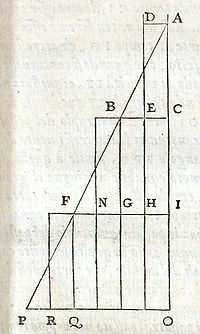Mean speed theorem

Galileo's demonstration of the law of the space traversed in case of uniformly varied motion. It's the same demonstration that Oresme had made centuries earlier.
In the 14th-century, the Oxford Calculators of Merton College and French collaborators such as Nicole Oresme proved the mean speed theorem, also known as the Merton mean speed theorem. It essentially says that: a uniformly accelerated body travels the same distance as a body with uniform speed whose speed is half the final velocity of the accelerated body.[1]
These medieval scientists demonstrated this theorem — the foundation of "The Law of Falling Bodies" — long before Galileo, who is generally credited with it. The mathematical physicist and historian of science Clifford Truesdell, wrote:[2]
The now published sources prove to us, beyond contention, that the main kinematical properties of uniformly accelerated motions, still attributed to Galileo by the physics texts, were discovered and proved by scholars of Merton college.... In principle, the qualities of Greek physics were replaced, at least for motions, by the numerical quantities that have ruled Western science ever since. The work was quickly diffused into France, Italy, and other parts of Europe. Almost immediately, Giovanni di Casale and Nicole Oresme found how to represent the results by geometrical graphs, introducing the connection between geometry and the physical world that became a second characteristic habit of Western thought ...
See also
- Science in the Middle Ages
- Scholasticism
Notes
- ↑ Boyer, Carl B. (1959). "III. Medieval Contributions". A History of the Calculus and Its Conceptual Development. Dover. pp. 79–89. ISBN 978-0-486-60509-8.
- ↑ Clifford Truesdell, Essays in The History of Mechanics, (Springer-Verlag, New York, 1968), pp.
Further reading
- Sylla, Edith (1982) "The Oxford Calculators", in Kretzmann, Kenny & Pinborg (edd.), The Cambridge History of Later Medieval Philosophy.
- Longeway, John (2003) "William Heytesbury", in The Stanford Encyclopedia of Philosophy.